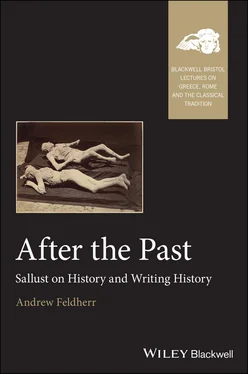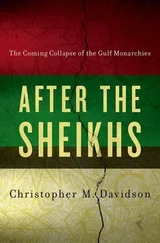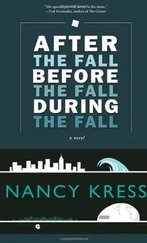12 12 See esp. Gurd’s 2007 analysis of Cicero’s late treatises as multiply authored, discussed in Chapter 6.
13 13 On Cicero’s need to defend his philosophical activities from the general devaluation of otium, see Baraz (2012), esp. pp. 13–43. See also Stroup (2010, 37–65).
14 14 For a recent comprehensive treatment of the issue of fictionality in the Eclogues, see Kania (2016); for the concept of autonomy in the poems and its social impact, Roman (2014, 113–21).
15 15 The best guide to Sallust’s political career is Syme (1964, 29–42).
16 16 See esp. Vretska (1976, 96); Egermann (1932, 27); Renehan (1976, 2000).
17 17 Syme (1964, 42–3).
18 18 See Tiffou (1973, 260–2).
19 19 So Tiffou (1973, 283), who argues that Sallust emphatically rejects the equation of historiography with a leisure activity, equivalent to other modes of literary composition. A few sentences before, he had said that “memory of the past” was the most useful of negotia (Jug. 4.1).
20 20 Baraz (2012, 22–36) is a striking exception to the bracketing of Sallust in the debates about literary activity in the period. Her argument, based on detailed readings of the prefaces, makes Sallust a foil to Cicero in his active rebuttal of the prevailing devaluation of his “leisure” activities. She also accepts that the writing of history per se was more easily accepted as an occupation for a man of the political class but argues that pursuing historiography to the exclusion of a public career would nevertheless have required defense (22 n. 26). Faced then with an easier case for the public good to be derived from his work, Sallust can adopt a more forthright strategy than Cicero in his philosophica. As will be seen in the chapters to follow, my understanding of Sallust’s positioning of his work differs from hers in two respects. First, I see the claims about leisure as more ambiguous: Sallust makes available readings of his work that link it to public action and also stress its distance from it; indeed, he draws authority from both positions. Second, as we will see, Sallust’s strategy will also prove crucial to defining the generic identity of his work, especially against oratory, where its impartiality is an advantage. Cf. also the similar comparison by La Penna (1968, 25–32), and the important article by Leeman (1954–5, pt. 2).
21 21 Leg. 1.5, on which see esp. Woodman (2012, 1–16) and Krebs (2009).
22 22 Wiseman’s (2014) arguments for situating historiographical performances at public occasions will be discussed in Chapter 6.
23 23 See the important discussion of Heldmann (1993, 3–8), more fully treated in Chapter 6.
24 24 Damon’s (2010) study of intertextuality in ancient historiography similarly reveals the uncertain status of historical works as both textual entities and pointers to real events. Strikingly, her first example of the difficulty of distinguishing textual allusion from historical reference involves one of the most traumatic moments of the civil wars, the beheading of Pompey the Great. As Moles (1983b) demonstrates, the many later texts that evoke this event seem also to refer to the Ur-account of it in the Histories of Asinius Pollio. To see Pompey’s head in the alluding texts connects their narratives more directly to this momentous and shocking occurrence, while an awareness of the intertextual history of the scene may tend to generalize and distance it.
25 25 Sandberg and Smith (2017) offers a rich collection of recent discussions of various modes of representing the past throughout the republic. For the diversity of the literary tradition, see esp. Levene (2007).
26 26 Crucial evidence in Cic. Fam. 5.12, discussed in Chapter 2.
27 27 For an overview, see Riggsby (2007). On Caesar, see esp. Riggsby (2006) and the recent collection by Grillo and Krebs (2019); on Sulla, Smith (2009) and Flower (2015).
28 28 On the latter aspect of Cicero’s writings, see esp. Rawson (1972).
29 29 The interpenetration of historiographic interpretation and historical action throughout Roman history, and especially during the triumviral period in which Sallust wrote, is particularly well captured in Henderson (1997, esp. pp. 91–3). However, where he asserts that “historical narratives blur their stake in their own hermeneutics with their interest in the legibility of the social text for the actor-participants, who must read events as they occur” (p. 92), I will argue instead that Sallust’s narratives expose the stakes of the different reading strategies they make available both by dramatizing them within the narrative and by never losing sight of the potential distance between readers and “actor-participants”.
30 30 Decisive demonstration in Syme (1964, 314–51), with earlier bibliography. Key defenses of the authenticity of the Invective and the Letters include Vretska (1961, 12–15 and 38–48) and Büchner (1967 and 1982, 20–88 and 468–72). There is also a very useful overview in Schmal (2001, 24–30), whose own position that the controversy is insoluble is challenged in turn as defeatist by Woytek (2004), himself convinced that Letters cannot be Sallustian. Samotta (2009) is a recent example of an interpretation of Sallust’s political beliefs that does employ evidence from the Letters; see esp. p. 18 n. 22, with further bibliography. See also Santangelo (2012).
31 31 Therefore, Santangelo’s caution (2019, 110) against taking account of such “cross-references” seems untenably restrictive.
32 32 Kraus (1999, 244).
33 33 Jug. 4–5. See my discussion in section 1 of chapter 2. On Sallust’s deferral of a declaration of why he writes history as a strategy of audience engagement, see also Tiffou (1973, 249). Also very important for this question is Due (1983), esp. pp. 121–2 on the inconsistencies in the justification of history writing in the Jugurtha preface. However, he concludes that the passage is largely, therefore, irrelevant for understanding Sallust’s true motives while I argue that the image it offers of historiography remains an important alternative for his readers to bear in mind.
34 34 Ant. Rom. 1.8.3 (άλλ’ έξ άπάσης δέας μικτν ναγωνίου τε κα θεωρητικς < κα δείας >, να κα τος περ τος πολιτικος διατρίβουσι λόγους κα τος περ τν φιλόσοφον σπουδακόσι θεωρίαν κα ε τισιν οχλήτου δεήσει διαγωγς ν στορικος ναγνώσμασιν, ποχρώντως χουσα φαίνηται). See Schultze (1986, 135).
35 35 So even in the generally favorable assessment of Syme (1964, 2) “his writing is … a kind of revenge.” See also Due (1983, 137).
36 36 Latte (1935, 47–59).
37 37 Note his first sentence (Syme 1964, 1): “Sallust conquered a new domain for the literature of the Latins”.
I would like to introduce the approach to Sallust’s monographs developed in this chapter with an image, to be found on the cover of this book: a photograph by Giorgio Sommer showing the gesso casts of two bodies found on the Via Stabiana in Pompeii. I do so because the contrasting ways of understanding this photograph as a representation of the past at once figure the effects I want to claim for Sallust’s work upon its first audience and suggest their continuities with modernity’s experience of the classical world. My own initial impression of the photograph was of temporal distance. This derived from the already antique-looking sepia tones of the image itself, in conjunction with the battered and fragmentary aspect of the figures, and recalled to me the kind of self-conscious archaism so notable in Sallust’s diction. But if the picture looks old now, it was also clear how modern it must have seemed at the time it was made, around 1875. Had the casts simply been set against a black background, the effect might have been one of timelessness. But the way that background resolves into a cloth spread out on a pavement summons up the entire process of excavation and display. The very modern medium of photography, and indeed the technique of using plaster to fill the spaces in the ash the dead bodies had occupied, evokes the recent discovery of the figures themselves as part of a scientific program of exploration. Sallust’s emphasis on his impartiality and other evocations of the newly recuperated models of Thucydidean historiography give a similarly cutting-edge quality to his accounts of the past. 1The image comments on the promise of modern technology to capture history as it really was, with an objectivity no recovered work of art or ancient text could match. It is ultimately the combination of the sense of being in the presence of the real thing—and again at a moment of emotional exposure that strips away cultural difference—with a deliberate evocation of the distance that makes the past recoverable that I found so urgent in the image. A contemporary observer unwittingly highlights the same paradox when he comments on similar but earlier images that “while looking at the pictures, it is difficult to divest the mind of the idea that they are not the works of some ancient photographer who plied his lens and camera after the eruption had ceased, so forcibly do they carry the mind back to the time and place.” 2
Читать дальше












